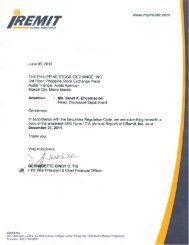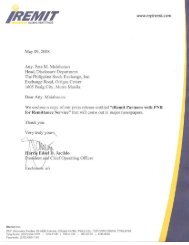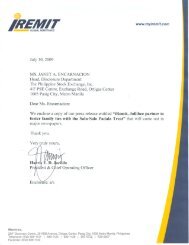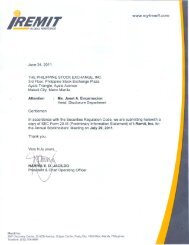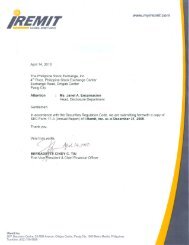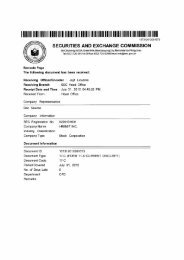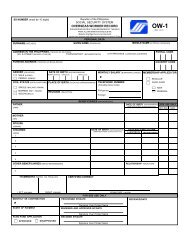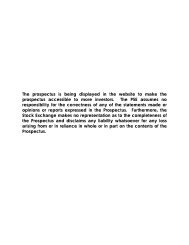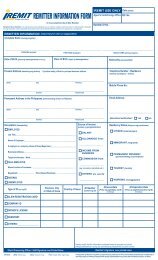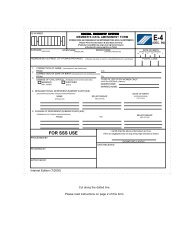SEC Form 20-IS - iRemit Global Remittance
SEC Form 20-IS - iRemit Global Remittance
SEC Form 20-IS - iRemit Global Remittance
You also want an ePaper? Increase the reach of your titles
YUMPU automatically turns print PDFs into web optimized ePapers that Google loves.
- 8 -<br />
Depreciation and amortization is calculated on a straight-line basis over the estimated useful life of<br />
the property and equipment as follows:<br />
Office and communication equipment 3 years<br />
Transportation and delivery equipment 3 to 5 years<br />
Furniture and fixtures 3 to 5 years<br />
Leasehold improvements 5 years or the term of the lease,<br />
whichever is shorter<br />
The carrying values of property and equipment are reviewed for impairment when events or<br />
changes in circumstances indicate the carrying value may not be recoverable. If any such<br />
indication exists and where the carrying values exceed the estimated recoverable amount, the asset<br />
or cash-generating units (CGU) are written down to their recoverable amount (see policy on<br />
Impairment of Nonfinancial Assets).<br />
An item of property and equipment is derecognized upon disposal or when no future economic<br />
benefits are expected from its use or disposal. Any gain or loss arising on derecognition of the<br />
asset (calculated as the difference between the net disposal proceeds and the carrying amount of<br />
the asset) is included in the parent company statement of income in the year the asset is<br />
derecognized.<br />
The asset’s residual values, useful lives and methods of depreciation and amortization are<br />
reviewed, and adjusted if appropriate, at each financial year-end to ensure that these are consistent<br />
with the expected pattern of economic benefits from the items of property and equipment.<br />
Software costs<br />
Software costs are carried at cost less accumulated amortization and any impairment in value. The<br />
cost of the asset is the amount of cash or cash equivalents paid or the fair value of the other<br />
considerations given up to acquire the asset at the time of its acquisition or production. Software<br />
costs are amortized on a straight-line basis over its estimated useful life of three (3) years.<br />
The asset’s amortization period and amortization method are reviewed at least at each balance<br />
sheet date. Changes in the expected useful life or the expected pattern of consumption of future<br />
economic benefits embodied in the asset is accounted for by changing the amortization period or<br />
method, as appropriate, and treated as changes in accounting estimates.<br />
Impairment of Nonfinancial assets<br />
Investments in subsidiaries and associates<br />
The Parent Company assesses at each balance sheet date whether there is any indication that its<br />
investments in subsidiaries and associates may be impaired. If any indication exists, the Parent<br />
Company estimates the asset’s recoverable amount. An asset’s recoverable amount is the higher<br />
of an asset’s or CGU’s fair value less cost to sell and its value in use. Where the carrying amount<br />
of an asset or CGU exceeds its recoverable amount, the asset is considered impaired and is written<br />
down to its recoverable amount.<br />
Property and equipment and software costs<br />
At each balance sheet date, the Parent Company assesses whether there is any indication that its<br />
property and equipment and software costs may be impaired. When an indicator of impairment<br />
exists or when an annual impairment testing for an asset is required, the Parent Company makes a<br />
formal estimate of recoverable amount. Recoverable amount is the higher of an asset’s (or<br />
CGU’s) fair value less costs to sell and its value in use and is determined for an individual asset,<br />
unless the asset does not generate cash inflows that are largely independent of those from other<br />
*SGVMC116501*



